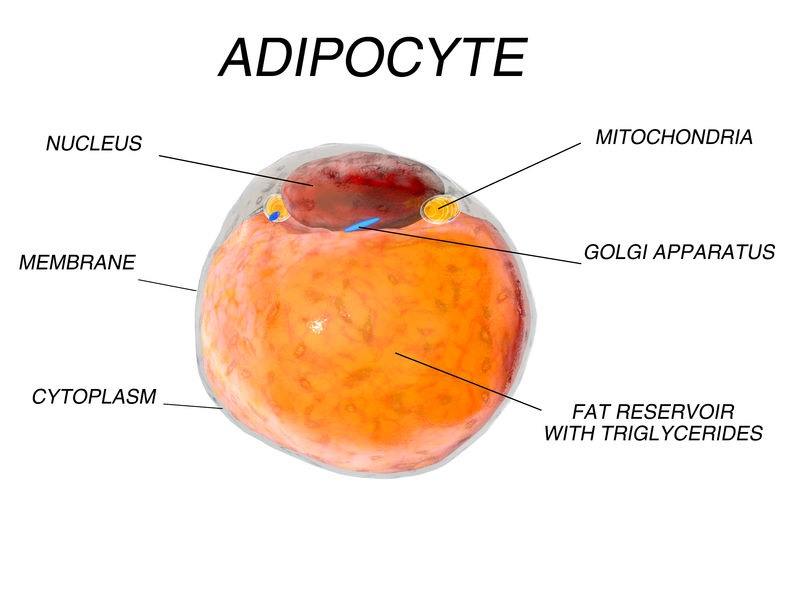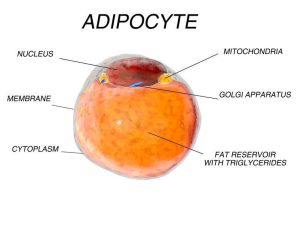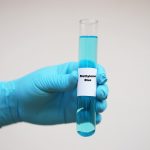
The myth that exercise can turn fat into muscle has been propagated for far too long. Scientifically speaking, there are vast differences between adipose (fat) cells and muscle fibers; and no amount of strength training or hours on the treadmill will convert one to the other. To help our personal training clients reduce their percentage of body fat, a deeper understanding of the etiology of fat cells itself is a good place to begin.
How Fat Cells are Formed and Grow
The majority of our fat cells are formed in utero during the fetal stages of development. In general, women possess more fat cells than men. An infant usually has about 5-6 billion fat cells. This number increases during early childhood and puberty, resulting in a healthy adult body possessing 25 to 30 billion fat cells.

In some individuals, there may be a genetic predisposition to having more fat cells. In the 1960’s, Dr. Jules Hirsch pioneered research that led to the development of the adipose cell hypothesis, which states that the number of fat cells in a human body is fixed, and that these cells can enlarge or shrink, depending on one’s diet. Hirsch believed that the individual fat cells of obese people are larger than those present in people of normal weight, and moreover, very obese individuals have more fat cells. However, more recent research has shed some light on the fact that, in cases of extreme weight gain, it is actually possible for the body to create a greater number of fat cells than were present at birth.
The average weight of an adult fat cell is about 0.6 micrograms, but they can vary in size from 0.2 micrograms to 0.9 micrograms. In addition to possibly containing an excessive number of fat cells, an overweight person’s fat cells can be up to three times larger than an individual with a more ideal body composition. This leads us to consider the dynamics of a relatively healthy man trying to lose 10 pounds versus a severely overweight man attempting to shed 50-60 pounds.
In order to shed unwanted pounds – and successfully keep them off – obese individuals will have to work harder than others to maintain a healthy weight. When weight is lost as a result of prudent dieting and a concerted effort at incorporating exercise into one’s lifestyle, the number of fat cells does not diminish; rather, the cells themselves “shrink”, or empty out, as the body calls upon them as an energy source.
Knowing that the abundant number of cells remains, diet and exercise must become a long-term habit; otherwise these cells will simply fill up again when the balance of “calories in/calories out” gets off-kilter. While the biological processes are the same for the man attempting to reduce his weight by 10 pounds, his fat cells are smaller to begin with, and will tend not to fill back up quite as easily if he cheats on his meal plan or misses one workout.
Dr. Gary Hausman, a scientist at the USDA’s Richard B. Russell Laboratory, has done research on fat cell development in fetal pigs, and was the first to show that the pituitary gland, which regulates overall growth, development and metabolism, also secretes several hormones that stimulate fat-cell growth and development. His research led to the conclusion that obesity may be associated with higher-than-normal levels of thyroid hormone combined with suppressed levels of growth hormone.
In other experiments, Hausman showed that glucose metabolism might also be a factor in early fat-cell formation. Fetal pigs that later grew obese had a higher level of glucose metabolism than those that evolved into having a more normal weight distribution. It was also observed that piglets born to overweight mothers had larger fat cells and absorbed more lipids from the bloodstream.
If genetics truly are to blame for obesity in some individuals, can this dynamic be overcome? Of course, the answer is yes. Diligence and adherence are the key factors to successfully kicking that gene pool to the curb and reclaiming a healthier life. Shrinking an overabundance of fat cells is not an easy task, but it can be accomplished with a great deal of success. Understanding what is taking place at a cellular level can be helpful in taking those extra steps to remain motivated in the quest for a leaner physique. Realizing that we may not have control over the number of fat cells with which we were born, we must harness the power to dominate those factors within our control, namely our exercise, nutrition, and most important of all, our mental attitude.
Fats & Health
Chemically, fats (or lipids), are hydrophobic (‘water fearing’) because they contain multiple carbon atoms bound to each other and are surrounded by hydrogen. This helps explain why oil doesn’t mix readily with water. Fat or adipose tissue is contained in many parts of our body.
The location of the adipose tissue can actually be good or bad for someone’s health. Some adipose tissue is located just beneath the skin, and is therefore known as sub-cutaneous fat.
Some adipose tissue can be located close to organs in the middle of the body, which is known as visceral adipose tissue (VAT).
Finally, some fats in the muscle are known as intramuscular triacylglycerol (IMTG) or intramuscular adipose tissue. The IMTG can be used as an immediate fuel source for muscle metabolism. Visceral fat has been found to increase a person’s risk of developing heart disease.
Fat as Fuel: The Slow & Steady Energy Source
Let us first recall that catabolism is the set of metabolic pathways that breaks down molecules into smaller units in order to release energy. With that said, fats require a comparatively involved handling process by the body. That is, they must be transported by means of carriers, they must have oxygen in order to be catabolized, and that catabolization must occur in the mitochondria. Oxidization is the term often used to describe the catabolism of fatty acids to produce energy.
The whole process can be likened to the routine of a person going to work: The person needs to go to work to earn money. He or she often is taken there by means of a vehicle (carrier), and upon arrival, the person must physically be in a certain part of the workplace in order to do the job. While there, the worker must have certain raw materials or a particular environment in order to perform the task.
The steps of fat oxidization include:
1) Emulsification of fat into smaller globules for absorption.
2) Lipolysis of triacylglycerols into fatty acids and glycerol
3) Removal of fatty acids from cells
4) Transport of fat by the bloodstream. The release of the fat is hydrolyzed (broken off) by lipoprotein lipase.
5) Transport of fats into the muscle cell- performed by a Fatty Acid Binding Protein (FABP) and a fatty acid transporter (FAT/CD36) protein.
6) Transport of fatty acids into the mitochondria, which is first turned into an acyl-CoA complex by acyl CoA synthetase and then transported across the mitochondrial membrane.
7) Oxidation of fatty acids in the Beta-oxidation pathway and the tricarboxylic acid (TCA, or Kreb’s) cycle.
As can be seen, the above steps involve special transporters and special enzymes and the availability of certain precursors and cellular structures. The process takes time, but it is a very efficient energy production process and the supply is essentially unlimited. Roughly 111,000 kcals are available in a man who weighs 80 kg (176 lbs) with 15% body fat.
Fat oxidation is based on several factors including the intensity and duration of exercise, the aerobic condition of the individual, dietary intake over the previous 48 hours, and carbohydrate intake before and during exercise. The two main sources of fatty acids in the body are plasma fatty acids and intramuscular fatty acids. Plasma fatty acids will be replenished by the process of lipolysis. It is worth noting that advances in technology have allowed scientists to trace sources, and thereby distinguish the relative contributions of each source at various intensities and durations of exercise.
When the body is at rest and someone begins exercise, the plasma fatty acids levels will decrease because the rate of lipolysis does not keep up with the use of plasma fatty acid. After about 15 minutes of exercise, the plasma fatty acid concentration will begin to return and peak at around 60 minutes of exercise–depending on the intensity. If the intensity for those 60 minutes is moderate, the plasma fatty acid concentrations will increase, but if the intensity is high, this increase will be minor or non-existent.
The Fat Burning “Zone” & Weight Loss
Studies have shown the maximum rate of fat oxidation occurs at about 63% VO2 max. The relative and absolute amounts of fat oxidation both increase at low exercise intensities (>25% VO2 max) as exercise intensity increases up to about 63% the relative proportion decreases, but the absolute amount increases. After 63% VO2 max (moderate intensity), the absolute amount decreases quickly from 65% to about 0 at 85% VO2 max. Glycogen and existing plasma glucose become increasingly important sources as intensity increases.
Thus, many people claim they need to be in their “fat-burning zone” to lose weight because they have been told they burn more fat at that intensity. This statement is valid; however it should be noted that the person is not burning more calories and this is what leads to maximum (or some instances, minimal) fat loss.
The body is constantly using both glycogen and fat as fuel and it doesn’t need our “guidance” in choosing which source to tap into to lose fat. It does, however, need our direction to get moving in the first place.
References
http://centennial.rucares.org/index.php?page=Obesity
http://science.howstuffworks.com/environmental/life/human-biology/fat-cell.htm
http://www.fitwatch.com/weight-loss/the-incredible-shrinking-fat-cell-what-really-happens-when-body-fat-is-burned-452.html







